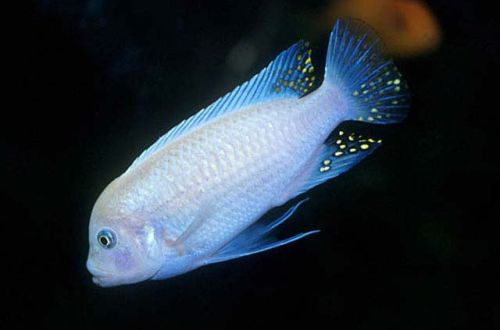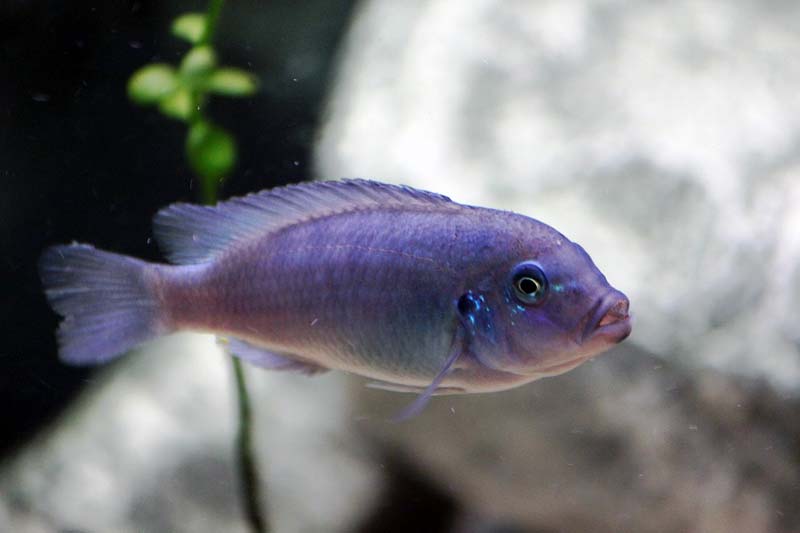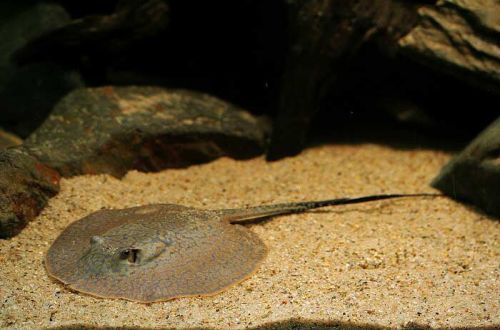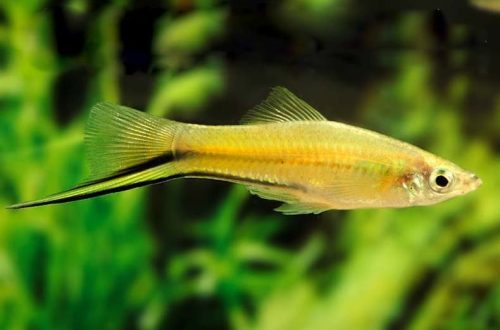
blue zebra
The blue zebra, scientific name Maylandia callainos, belongs to the Cichlidae family. Formerly belonged to the genera Pseudotropheus and Metriaclima. Representative of the group of Malawian cichlids Mbuna, characterized by bright colors and interesting behavioral features. Aggressive, so you need to carefully consider the choice of compatible species.

Contents
Seda habitat
Endemic to Lake Nyasa (Malawi), located in the rift valley on the African continent on the border of Mozambique, Malawi and Tanzania. The fish is found along the northern coast among the heaps of stones and rocks.
Brief information:
- The volume of the aquarium – from 150 liters.
- Temperature – 24-28°C
- Value pH — 7.6–8.8
- Water hardness – medium and high hardness (8-25 dGH)
- Substrate type – sandy, rocky
- Lighting – subdued or moderate
- Brackish water – no
- Water movement – light or moderate
- The size of the fish is about 13 cm.
- Nutrition – any feed with herbal supplements
- Temperament – inhospitable
- Keeping in a harem with one male and several females
Description

Adult individuals reach a length of about 13 cm. The color of the body is pale blue with barely noticeable dark vertical stripes. Sexual dimorphism is weakly expressed. Unlike females, males are somewhat larger, have an enlarged frontal part on the head and have a characteristic pattern on the anal fin in the form of yellow specks.
Outwardly, it is very similar to one of the color forms of the Red Zebra Cichlid. Despite the name, some varieties of which are blue in color and are almost identical to the Blue Zebra.
Food
In nature, they feed on algae and the organisms inhabiting them, scraping food from the surface of stones and rocks. In the home aquarium, it is necessary to provide a diet rich in vegetable matter. A good choice for the beginner aquarist is a special Mbuna cichlid food that contains all the necessary ingredients for a balanced diet.
Maintenance and care, arrangement of the aquarium
The optimal volume of the tank for 5-6 fish starts from 150 liters. In the design, it is enough to use sandy soil, large stones, rocks from which shelters are formed in the form of crevices and grottoes. There is no need to place live plants, natural driftwood and other decorative elements inherent in tropical aquariums. Such an “empty” landscape is quite consistent with the natural habitat of this species.
For long-term maintenance, it is important to provide and maintain a high pH and dGH hydrochemical composition of the water. Prevent the accumulation of organic waste (feed leftovers, excrement) by regularly cleaning the soil with a siphon. Replace part of the water with fresh water weekly.
Behavior and Compatibility
Aggressive territorial look. In small aquariums (about 100 liters), males will not be tolerant of each other, and will also attack other fish. Under these conditions, keeping according to the type of harem is permissible, when there are 3–4 females per male. Large tanks (hundreds of liters) can accommodate a more diverse community of several Mbuna, Aulonokara and Utaka.
Breeding / breeding
Favorable conditions for spawning are a water pH of 8.2–8.5, a temperature of 25–27°C, and a protein-rich diet. With the onset of the breeding season, the male chooses a place on the bottom for future clutches. Usually it becomes a flat stone or any other similar surface. When a place is chosen, the courtship process begins. At times, courtesies can be overly aggressive. It is in order to dispel the attention of the male that harem content is necessary. Having accepted courtship, the female approaches the spawning site and lays several dozen eggs, and after fertilization takes them into her mouth, where they will stay for a month until the fry appear.
The presence of shelters will protect the female during the incubation period from excessive attention from the male. If you do not provide places for shelters, then there is a high risk that the female will release eggs ahead of time.
Some breeders transplant females into a separate tank during this time. But it is worth remembering that if the fish is outside the colony for too long, then it will lose its place in the hierarchy and will be attacked upon return.
Fish diseases
Hardy and unpretentious fish. Health problems are usually associated with injury, poor diet and exposure to unsuitable aquatic environments (low pH and dGH). Eliminating external causes has a positive effect on well-being. If symptoms persist, medical treatment will be required. Read more in the section “Diseases of aquarium fish”.





